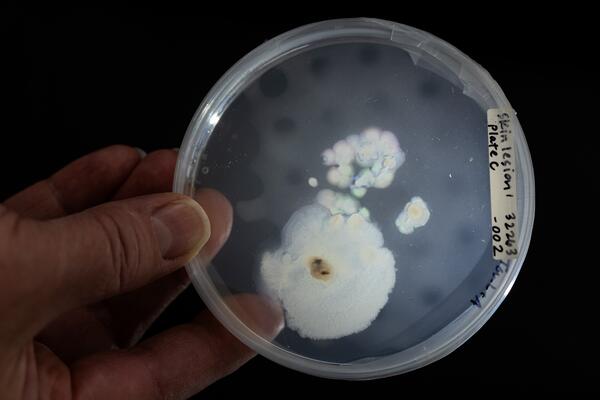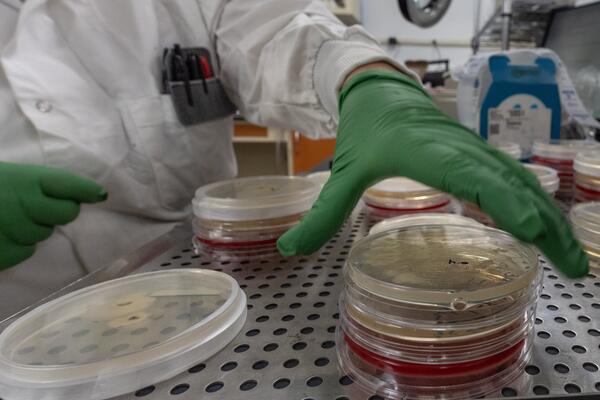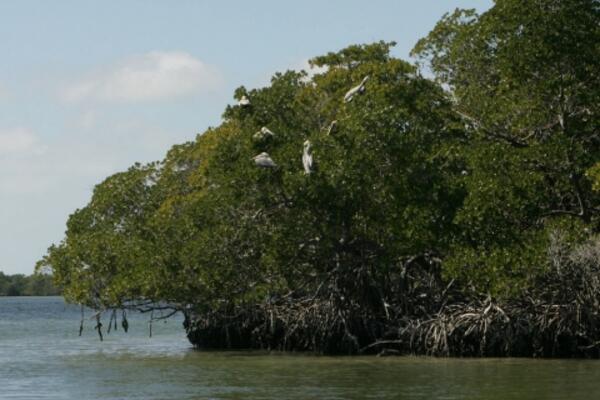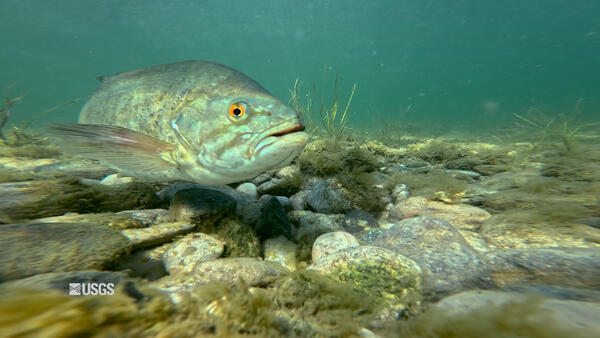A USGS scientist examines a skin sample from a salamander as part of a study to investigate for potential pathogens.
Multimedia
Below are multimedia (photos, graphics, audio, and video) associated with the Ecosystems Mission Area.
Be certain to check out Outstanding in the Field, an original podcast series that tells stories about our science, our adventures, and our efforts to better understand fish and wildlife and the ecosystems that support them.
Images
A USGS scientist examines a skin sample from a salamander as part of a study to investigate for potential pathogens.
A USGS scientist reaches for a microbiological plate with cultures from salamander skin to investigate for potential pathogens.
A USGS scientist reaches for a microbiological plate with cultures from salamander skin to investigate for potential pathogens.
A USGS scientist prepares to analyze a skin swab from a salamander to investigate for potential pathogens.
A USGS scientist prepares to analyze a skin swab from a salamander to investigate for potential pathogens.
A USGS scientist examines microorganisms from salamander skin to investigate for potential pathogens.
A USGS scientist examines microorganisms from salamander skin to investigate for potential pathogens.
Red mangrove and brown pelicans at Ten Thousand Islands, Florida. Ecosystems are more than a static collection of plants and animals. An ecosystem is a dynamic set of processes that supports species and with which species interact. Ecosystems don’t just have structure, they have functions.
Red mangrove and brown pelicans at Ten Thousand Islands, Florida. Ecosystems are more than a static collection of plants and animals. An ecosystem is a dynamic set of processes that supports species and with which species interact. Ecosystems don’t just have structure, they have functions.

USGS Scientists Collecting Tissue Samples from a Rainbow Trout on Ross Lake.
USGS Scientists Collecting Tissue Samples from a Rainbow Trout on Ross Lake.This is a photo of scientists, Ben Jensen and Shelley Johnson, collecting tissue samples from a rainbow trout on Ross Lake. The USGS Western Fisheries Research Center does work on Ross Lake to understand the food web and ecology for salmon.
USGS Scientists Collecting Tissue Samples from a Rainbow Trout on Ross Lake.
USGS Scientists Collecting Tissue Samples from a Rainbow Trout on Ross Lake.This is a photo of scientists, Ben Jensen and Shelley Johnson, collecting tissue samples from a rainbow trout on Ross Lake. The USGS Western Fisheries Research Center does work on Ross Lake to understand the food web and ecology for salmon.
Videos
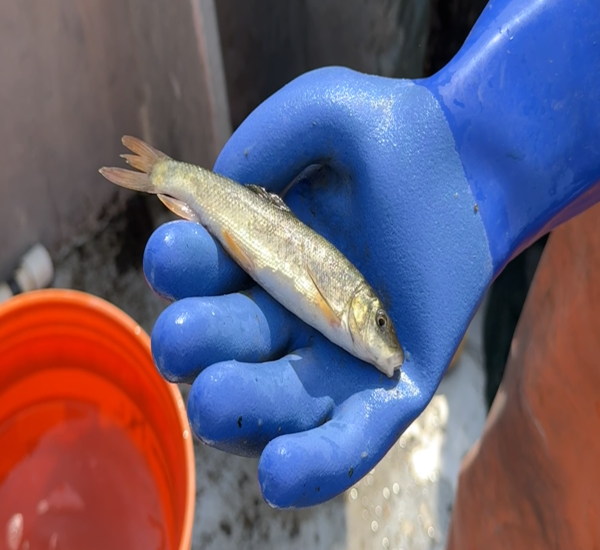 Endangered Klamath Sucker fish held in hand with glove above bucket of water
Endangered Klamath Sucker fish held in hand with glove above bucket of water
This is a video of a juvenile sucker in Upper Klamath Lake, OR. Through decades of research, scientists at the USGS Western Fisheries Research Center have determined that over the last 30 years something has prevented young suckers from reaching adulthood. Scientists work tirelessly to find the cause of this break in recruitment into adulthood.
This is a video of a juvenile sucker in Upper Klamath Lake, OR. Through decades of research, scientists at the USGS Western Fisheries Research Center have determined that over the last 30 years something has prevented young suckers from reaching adulthood. Scientists work tirelessly to find the cause of this break in recruitment into adulthood.
Unexpected Lessons from Invasive Adirondack Smallmouth Bass
Unexpected Lessons from Invasive Adirondack Smallmouth BassDecades of invasive smallmouth bass removal from the Adirondacks resulted in a novel discovery of rapid evolution. Despite the absence of a clear physiological adaptation pathway, intensive manual removal produced a larger population of the invasive predatory fish, growing faster and maturing earlier.
Unexpected Lessons from Invasive Adirondack Smallmouth Bass
Unexpected Lessons from Invasive Adirondack Smallmouth BassDecades of invasive smallmouth bass removal from the Adirondacks resulted in a novel discovery of rapid evolution. Despite the absence of a clear physiological adaptation pathway, intensive manual removal produced a larger population of the invasive predatory fish, growing faster and maturing earlier.
Climate refugia are places that may be buffered from and likely won’t change as much under climate change. Focusing research on these areas may offer resource managers more conservation and management options.
Climate refugia are places that may be buffered from and likely won’t change as much under climate change. Focusing research on these areas may offer resource managers more conservation and management options.
Climate Refugia: A Buffer from Climate Change (AD)
Climate Refugia: A Buffer from Climate Change (AD)Climate refugia are places that may be buffered from and likely won’t change as much under climate change. Focusing research on these areas may offer resource managers more conservation and management options.
Climate Refugia: A Buffer from Climate Change (AD)
Climate Refugia: A Buffer from Climate Change (AD)Climate refugia are places that may be buffered from and likely won’t change as much under climate change. Focusing research on these areas may offer resource managers more conservation and management options.
Ammonia or ammonium? What’s the difference? In water, ammonia (NH3) and ammonium (NH4+) exist together in an equilibrium that depends on pH and temperature. As the temperature or pH rise, ammonia (NH3) becomes more abundant. This is important because ammonia is more toxic than ammonium.
Ammonia or ammonium? What’s the difference? In water, ammonia (NH3) and ammonium (NH4+) exist together in an equilibrium that depends on pH and temperature. As the temperature or pH rise, ammonia (NH3) becomes more abundant. This is important because ammonia is more toxic than ammonium.
 image of first video slide
image of first video slide
Saline Lake Ecosystems IWAA Spring Seminar: Project Updates and 2025 Field Season Plans
Saline Lake Ecosystems IWAA Spring Seminar: Project Updates and 2025 Field Season PlansThis video presents the Spring 2025 Saline Lake Ecosystems Integrated Water Availability Assessment Spring Seminar by the U.S. Geological Survey (USGS). Hosted by Allison Shipp, the seminar provides updates on how hydroclimatic changes and water management affect terminal lake ecosystems and waterbird populations.
Saline Lake Ecosystems IWAA Spring Seminar: Project Updates and 2025 Field Season Plans
Saline Lake Ecosystems IWAA Spring Seminar: Project Updates and 2025 Field Season PlansThis video presents the Spring 2025 Saline Lake Ecosystems Integrated Water Availability Assessment Spring Seminar by the U.S. Geological Survey (USGS). Hosted by Allison Shipp, the seminar provides updates on how hydroclimatic changes and water management affect terminal lake ecosystems and waterbird populations.
Audio
USGS Outstanding in the Field, Episode 11, Designing Accessible Research for Rural Communities
USGS Outstanding in the Field, Episode 11, Designing Accessible Research for Rural CommunitiesThis is a special edition of Outstanding in the Field, the U.S. Geological Survey’s podcast series produced by the Ecosystems Mission Area. In this episode we highlight stories from the Alaska Voices podcast, a partnership between the U.S. Geological Survey’s Alaska Climate Adaptation Science Center and the University of Alaska Fairbanks.
USGS Outstanding in the Field, Episode 11, Designing Accessible Research for Rural Communities
USGS Outstanding in the Field, Episode 11, Designing Accessible Research for Rural CommunitiesThis is a special edition of Outstanding in the Field, the U.S. Geological Survey’s podcast series produced by the Ecosystems Mission Area. In this episode we highlight stories from the Alaska Voices podcast, a partnership between the U.S. Geological Survey’s Alaska Climate Adaptation Science Center and the University of Alaska Fairbanks.
Welcome to the USGS Ecosystems Mission Area Outstanding in the Field podcast series that tells stories about our science, our adventures, and our efforts to better understand fish and wildlife and the ecosystems that support them.
Welcome to the USGS Ecosystems Mission Area Outstanding in the Field podcast series that tells stories about our science, our adventures, and our efforts to better understand fish and wildlife and the ecosystems that support them.
Welcome to another episode of Outstanding in the Field, the U.S. Geological Survey’s podcast series produced by the Ecosystems Mission Area. We highlight our fun and fascinating fieldwork studying ecosystems across the country. Today we’ll be discussing tiny communities that are found on the surface of the soil in the harsh environments of cold and hot deserts.
Welcome to another episode of Outstanding in the Field, the U.S. Geological Survey’s podcast series produced by the Ecosystems Mission Area. We highlight our fun and fascinating fieldwork studying ecosystems across the country. Today we’ll be discussing tiny communities that are found on the surface of the soil in the harsh environments of cold and hot deserts.
USGS Outstanding in the Field, Episode 8, Braving thin ice
USGS Outstanding in the Field, Episode 8, Braving thin iceThis is the first in a special edition of Outstanding in the Field, the U.S. Geological Survey’s podcast series produced by the Ecosystems Mission Area. In this series we will be highlighting stories from the Alaska Voices podcast, a partnership between the U.S. Geological Survey’s Alaska Climate Adaptation Science Center and the University of Alaska Fairbanks.
USGS Outstanding in the Field, Episode 8, Braving thin ice
USGS Outstanding in the Field, Episode 8, Braving thin iceThis is the first in a special edition of Outstanding in the Field, the U.S. Geological Survey’s podcast series produced by the Ecosystems Mission Area. In this series we will be highlighting stories from the Alaska Voices podcast, a partnership between the U.S. Geological Survey’s Alaska Climate Adaptation Science Center and the University of Alaska Fairbanks.
Outstanding in the Field Episode 7 - Science in the Swamp
Outstanding in the Field Episode 7 - Science in the SwampIn this episode of Outstanding in the Field, we take you to the swamps and coastal wetlands of Louisiana, the land of bayous and beignets and a state with one of the most dynamic coastlines in the United States. The wetlands that make up the Louisiana coast are vast and help protect important cultural and natural resources.
Outstanding in the Field Episode 7 - Science in the Swamp
Outstanding in the Field Episode 7 - Science in the SwampIn this episode of Outstanding in the Field, we take you to the swamps and coastal wetlands of Louisiana, the land of bayous and beignets and a state with one of the most dynamic coastlines in the United States. The wetlands that make up the Louisiana coast are vast and help protect important cultural and natural resources.
USGS Outstanding in the Field - Not Enough Beaches in Grand Canyon?
USGS Outstanding in the Field - Not Enough Beaches in Grand Canyon?In this episode of Outstanding in the Field, we are talking about beaches in a place that most people probably would not think of—the Grand Canyon.
USGS Outstanding in the Field - Not Enough Beaches in Grand Canyon?
USGS Outstanding in the Field - Not Enough Beaches in Grand Canyon?In this episode of Outstanding in the Field, we are talking about beaches in a place that most people probably would not think of—the Grand Canyon.


